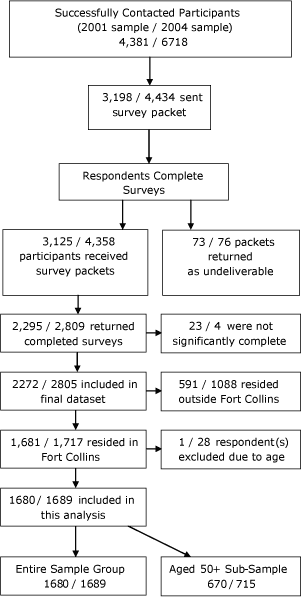The impact of a communitywide smoke-free ordinance on smoking among older adults
- PMID: 19080023
- PMCID: PMC2644603
The impact of a communitywide smoke-free ordinance on smoking among older adults
Abstract
Introduction: Clean-air and smoke-free ordinances have been shown to reduce the prevalence of smoking among the overall population, but their effects on the smoking prevalence among older adults deserves further attention. We examined changes in self-reported cigarette smoking and in attitudes toward smoking after the implementation of such ordinances in Fort Collins, Colorado, in 2003.
Methods: Communitywide health status surveys were mailed out to northern Larimer County residents recruited via random-digit dialing in 2001 and 2004. Secondary data analysis was conducted for respondents living in Fort Collins, comparing the entire sample with a subsample of adults aged 50 years or older. Univariate analyses were used to determine differences in self-reported cigarette smoking between the groups across the 2 surveys. Multivariate logistic regression models estimated differences in smoking status and in attitudes toward acceptability of public smoking between the 2 survey administrations, controlling for demographic correlates.
Results: Smoking rates among older respondents failed to change, despite significant decreases in smoking rates in the entire adult population. Furthermore, attitudes toward smoking in public did not change between the 2 surveys for either of the groups.
Conclusion: Different factors may influence the decision to stop smoking for older adults and younger adults. We recommend the use of multiple approaches on different ecological levels to ensure that communitywide antismoking intervention efforts reach all population segments.
Figures
References
-
- Centers for Disease Control and Prevention Annual smoking-attributable mortality, years of potential life lost, and productivity losses — United States, 1997-2001. MMWR Morb Mortal Wkly Rep. 2005;54(25):625–628. - PubMed
-
- Centers for Disease Control and Prevention 54 44 2005. 1124 1127 State-specific prevalence of cigarette smoking and quitting among adults — United States, 2004 MMWR Morb Mortal Wkly Rep. - PubMed
-
- Cataldo JK. Smoking and aging. Clinical implications. Part I: health and consequence. J Gerontol Nurs 2003;29(9):15–20. - PubMed
-
- Centers for Disease Control and Prevention. Behavioral Risk Factor Surveillance System survey data. Atlanta (GA): US Department of Health and Human Services; 2006.
MeSH terms
Grants and funding
LinkOut - more resources
Full Text Sources
Medical


